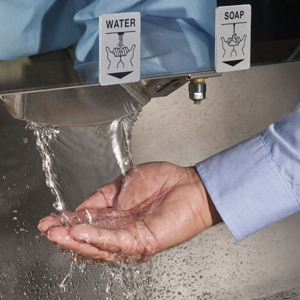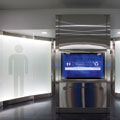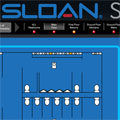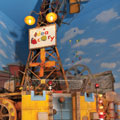
Recovering 100% of the lavatory water for use in flushing water closets
allows the use of custom-made Sloan sensor-activated faucets. Photos courtesy of Sloan Valve Co.
Chicago’s Museum of Science and Industry has a reputation for being a world-class museum with a focus on educating the public about inventions, scientific discoveries and other notable historic developments through the ages.
It should be no surprise, then, that the museum, which features exhibits highlighting mankind’s grandest ideas, would be open to exploring new ideas of its own to meet facility operational requirements.
When the museum renovated its largest public restrooms on the main floor and added two sets of restrooms, the facilities management team chose to install water-efficient fixtures. Moreover, the restroom projects offered a prime opportunity to test Sloan Monitored Systems (SMS), a networked, software-based water-control system from Sloan Valve Co., in those three restrooms.
Water savings began when the museum installed low-consumption fixtures in place of older fixtures using more water. The facility replaced manual 3.5 gpf water closets with sensor-operated 1.6 gpf water closets, manual 1.5 gpf urinals with water-free urinals and manual metering faucets operating at 0.25 gallons-per-use with sensor-activated 0.5 gpm faucets (green water closets, water-free urinals and sensor-activated faucets by Sloan Valve).
The water closet and faucet updates alone have reduced water usage by approximately 800,000 gallons each year. Installing the water-free urinals, as well as a graywater system that recovers lavatory water to flush some of the water closets, saves the museum another 250,000 gallons of water annually. Together, the water-efficiency systems save almost 1.1 million gallons each year.

A graywater system, which supplies water to flush 14 of the water
closets, saves the museum 250,000 gallons of water annually.
The Brains of the Operation
What truly sets the museum’s water-efficiency plumbing apart from a typical facility, however, is the behind-the-scenes automation enabled through SMS.KJWW Engineering Consultants Senior EngineerJim Boyanchek, P.E., LEED AP, consults on many projects, but “no other customer of mine is doing this,” he says. Although he says that many facilities could benefit from plumbing automation and controls, especially other large buildings with transient occupancies, a plumbing implementation such as this based on the building automation system model is new to him. KJWW is the Chicago firm responsible for the mechanical, electrical, plumbing and fire protection design for the project, while Chicago-based Ross Barney Architects is the architectural firm of record.
In terms of operation, traffic sensors at the door to each restroom count how many people enter. Infrared sensors located at each water closet and water-free urinal aid in restroom monitoring. This is particularly helpful in ensuring that housekeeping replaces the water-free urinal cartridges before they are depleted (the system issues a warning when a urinal comes within about 100 uses of expiration).

Chicago’s Museum of Science and Industry
is the largest science museum in the Western hemisphere.
A VOC sensor that monitors air quality in each of the restrooms is also connected to SMS. Air quality issues could range from a higher than acceptable level of sewer gas to a visitor smoking in the restroom.
“The system works flawlessly,” saysJ. Jeffery Johnson, AIA, LEED AP, director of facilities for the museum.
SMS alerts feed into a computer in the central dispatch office, which is monitored 24/7, and tie into the museum’s work-order system, which may either send an e-mail to the housekeeping staff office or automatically generate work tickets. SMS typically sends alerts on more everyday matters, such as soap dispensers needing to be refilled, rather than emergencies.
In the case of a more serious issue, such as a lavatory blockage, a plumber is dispatched directly to the issue. Automatic, system-generated reports are sent weekly that chronicle restroom use, the number of alerts sent and serviced, along with the amount of fresh water and graywater used.
Since the system was installed, restroom service has actually improved. Consumable outages are no longer a problem and housekeeping managers have gained workforce flexibility.
“It’s been a great assistance to us,” Johnson states. “If we get a call that a dispenser is out or there’s a clog, we can selectively pull people from other spaces to take care of that on an ad hoc basis vs. dedicating personnel to restrooms 100% of the time.”
Another added benefit: Requests for restroom supplies have gone down. Johnson surmises that using resources more efficiently has resulted in less waste.

Building management can view
up-to-the-moment measures of water usage, occupancy, etc. for restrooms
networked with Sloan Monitored Systems.
Variances Required For Unique Setup
Graywater is the primary source of water for 14 of the 50 toilets in restrooms with SMS. Although the museum would prefer to have all toilets pulling water from the graywater system, not enough water is generated by lavatory use to flush all of them.Boyanchek says that the museum “had to sell” its unique water conservation plans to code officials. The museum gained special approval from the city and state to install the water-free urinals and the graywater system. Custom-made 2.2 gpm sensor-activated faucets from Sloan are the sole source of recycled water for flushing the 14 toilets. The higher flow rate was permitted because the 32 faucets supply water to the graywater system, and all the water is captured and reused. Nothing goes to waste.
Even at these limited levels, the museum is ahead of many of its peers when it comes to water efficiency. The museum, which is keen on bringing SMS to other restrooms in the future, is the only cultural institution in Illinois with a stand-alone graywater system for restrooms. It’s also the first institution in the state to roll out dozens of water-free urinals.

The Idea Factory, an interactive exhibit, is another way that water is
creatively used in the museum.
“At this point in time, challenges with soap accumulation and filtration make this a high-maintenance application,” Boyanchek says. Graywater systems of this scale are “only for a very committed owner” who has the maintenance staff to support them.
But at the end of the day, guests accustomed to stepping into the facility’s grand halls to view the innovative, interactive exhibits are now also benefitting from the museum pushing the technological edge in its restrooms.